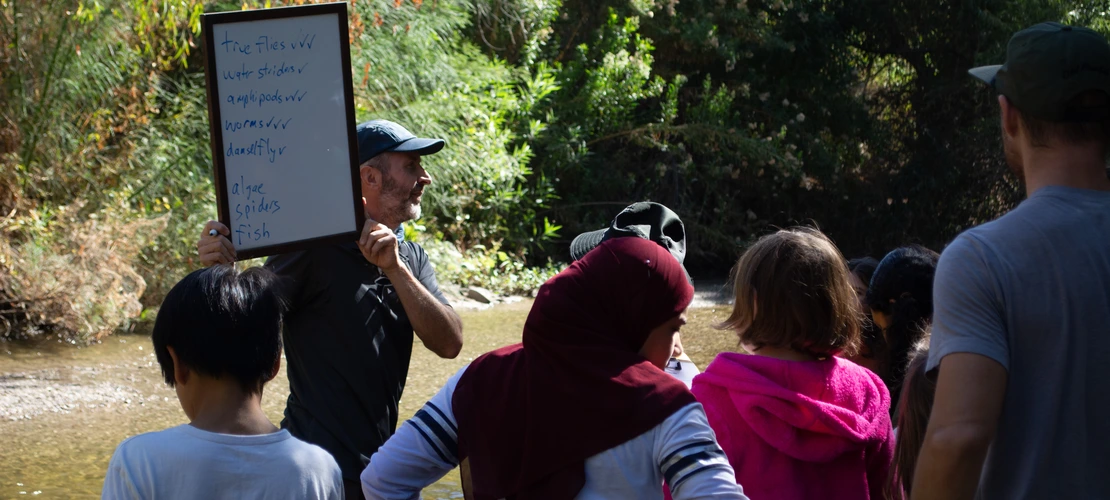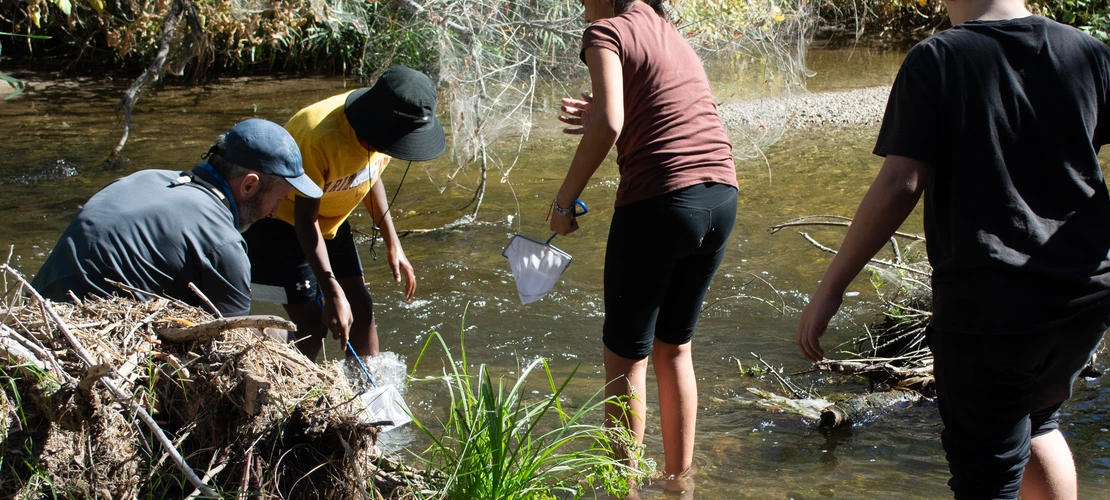Aquatic Oasis
Aquatic Oasis
Conserving and restoring habitat for desert fish, insects and amphibians to thrive.
By Olivia Miltner, Arizona Environment Program Coordinator | Dec. 5, 2023
You can hear them before you see them: 20 rambunctious 6th graders, three hours into their field trip, emerging from a tunnel to traipse to the river’s edge.
The spot is surrounded by lush green trees, with a cool breeze, birds flying overhead and the steady flow of water swirling downstream. For a moment, it’s easy to forget this sanctuary is in the middle of the Sonoran Desert.
A student, momentarily caught off balance, stumbles into the water and emerges with a giggle.
Michael Bogan, associate professor in the School of Natural Resources and the Environment at the University of Arizona, gathers his frenetic audience for a moment to provide directions for the morning’s activity: sampling and identifying invertebrates from the river.
The field trip is part of Bogan’s National Science Foundation-funded Biological Research Experience for Teachers Site. BIORETS, for short, supports immersive experiences along the Santa Cruz River to introduce and educate teachers and students about the biodiversity of aquatic and riparian ecosystems that exist right here in Southern Arizona.
“I love seeing that spark, especially from a student who hasn't been in the river before, or even looked at the bugs before,” Bogan said. “Suddenly, their face lights up and they really see the excitement, and it's amazing.”
Aquatic and riparian ecosystems across Arizona and the Southwest support a magnificent diversity of species uniquely adapted to challenging desert conditions. However, despite their resilience to such environmental conditions, human activity has threatened these sanctuaries throughout the past century.
To help protect these extraordinary creatures, researchers and educators at the University of Arizona are raising awareness of the presence and wonder of desert aquatic ecosystems and the creative measures being taken to revitalize these areas around Tucson.
One such faculty member is Scott Bonar, professor in the School of Natural Resources and the Environment. Coming from Washington state, he said when he first got the call to interview for a position at the University of Arizona, he thought to himself, “Why would I want to go down there? It's dusty. It's a desert. What the heck does that have to offer a fish biologist?”
Then, he got to know the desert fishes. Trout up in the mountain streams; the razorback sucker and the humpback chub, which can maintain themselves in the roaring current of Colorado River; small pupfishes that live in isolated springs tens of miles away from other waters.
“We have these wonderful native fishes that are part of Arizona's heritage, the Southwest’s heritage, and North America's heritage,” Bonar said. “I just fell in love with the place because it is so neat.”
That’s how one April, Scott Bonar found himself on foot, student in tow, doing circles in the middle of Death Valley. He was looking for the last thing you would expect to find in one of the hottest places on Earth: a fish.
Specifically, the Cottonball Marsh pupfish – a tiny, silvery creature that somehow lives in water that reaches over 100 degrees Fahrenheit and is five times the salinity of seawater.
“To get to this fish, you can only do it at certain times of the year because you can't carry enough water to get out there,” Bonar said.
Bonar and his student hiked and hiked and hiked out onto these salt flats in the middle of nowhere. It was still spring, but the temperature was already hitting the top of the thermometer.
“We’re sucking down water, and we get out there, and we couldn't find them,” he said.
Finally, the pair ran across a hidden little creek with banks that were entirely covered in salt, “and this little pupfish is just darting around dealing with it!” Bonar exclaimed.
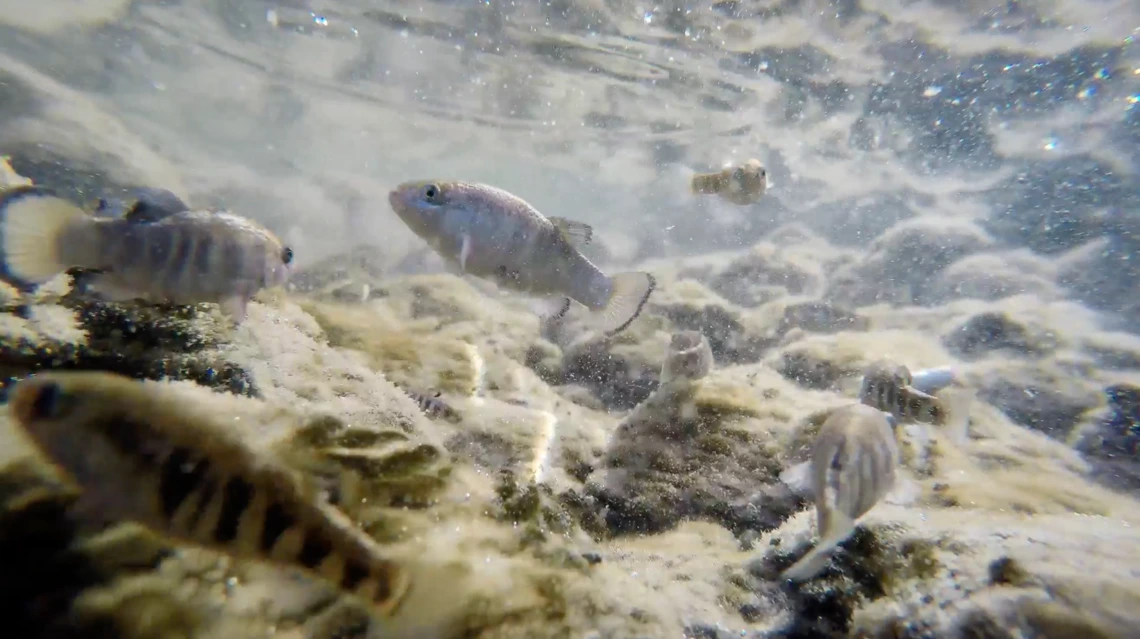
Cottonball Marsh Pupfish swim in a small body of water in Death Valley.
Footage by Taylor Ulrich and Scott Bonar.
Part of the reason for the variation in these species is the isolation of their habitats. Many of these fish live in small water bodies that might be separated by tens of miles from the next. Each has its own unique ecosystem, its own little world.
However, these species have been threatened by three primary forces over the past century, Bonar said. Historically, excessive aquifer pumping lowered groundwater levels, drying up rivers that used to flow perennially, like the Santa Cruz. Meanwhile, climate change impacts such as intensified wildfires, extreme heat and drought also shrink aquatic habitat, further stressing species.
The final factor stems from one of the largest mass animal migrations in contemporary U.S. history, Bonar said. Back in the 1800s when colonizers were exploring the Western U.S., they noticed that the fish were different from the ones they were used to.
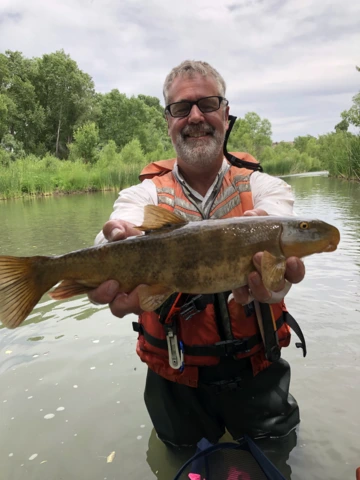
Photo courtesy Scott Bonar.
“The management agency of the day, the U.S. Fish Commission, said, ‘How are we going to get fish out to these people because they don't like to eat these weird desert fishes with big humps on them,’” Bonar said.
Their solution? Shipping out carp, brown trout, bass, catfish and other species on rail cars specifically designed to transport fish.
“The thing is, the fishes back East evolved with lots of different species. They’re used to fighting with each other, and they were able to deal with some of the desert habitat conditions” Bonar said. “The native fish out here, they dealt with harsh habitat conditions, but these Eastern fish could really beat up on the natives, and they did.”
Now, non-native species threaten to out-compete native fish, particularly in areas where natural water flow has been disrupted, like in dam reservoirs; desert fish are adapted to withstand big surges like flash floods, while deep lakes such as Lake Powell are ideal for Eastern fishes.
“That puts the non-natives at an additional disadvantage,” Bonar said.
According to the U.S. Fish and Wildlife Service, Arizona is home to 12 species of endangered fish, one endangered amphibian (the Sonoran tiger salamander), and one endangered reptile (the Sonoyta mud turtle).
Habitat conservation is a key component of protecting these species, and throughout the past decade, partnership between the City of Tucson, Pima County, the Sonoran Institute and the University of Arizona have contributed to the restoration of such ecosystems in Tucson, including the re-introduction of endangered species.
Central to these efforts have been the utilization of highly treated effluent as a source of continuous water flow along sections of the Santa Cruz River. In 2013, water treatment plants in northwest Tucson were upgraded to release higher quality water into the Santa Cruz, catalyzing the lush vegetation and wildlife that Dr. Bogan’s students were able to explore.
Related Content
This section of the Santa Cruz is now Pima County’s longest continually flowing section of the river, as Pima County’s water reclamation facilities have been releasing effluent into the river year-round there since the 1970s. However, given the lower quality of wastewater released prior to 2013, Bogan says it’s important to recognize the lingering concerns and questions people may have about this effluent.
“That's in part why we do these field trips, to show people and to let them see that the water is clean,” Bogan said.
Part of his activity with students is to test the water’s pH, temperature, and similar conditions.
“We are lucky in Tucson that we never really had much in the way of industrial development, so we don't have the same legacy issues of water quality,” Bogan said. “There are persistent nasty chemicals in a lot of those industrial waterways that have taken decades to clean up. We don't have that here. We just had way too many nutrients that were making it toxic to aquatic life.”
Now, the area is flourishing, supporting more than 200 bird species, over 60 dragonfly species, as well as the Sonora mud turtle and the endangered Gila topminnow.
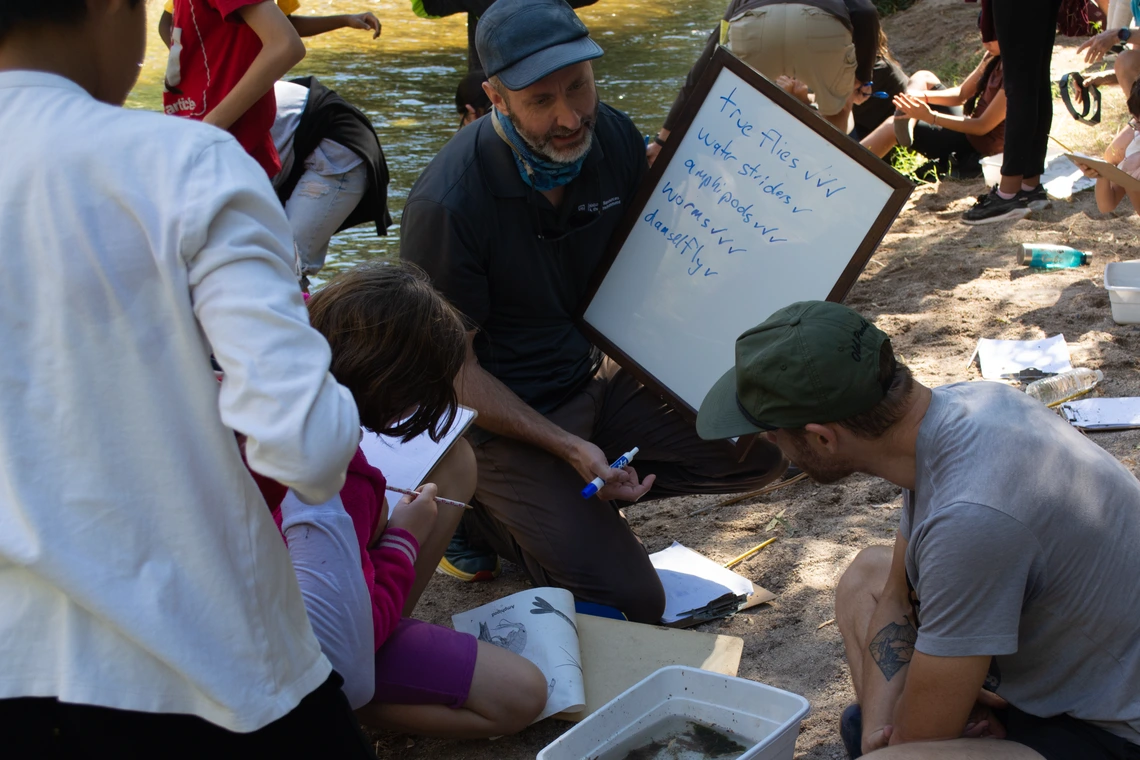

Michael Bogan explores the Santa Cruz River with students on a field trip as part of his BIORETS program.
Bogan said although the effluent is a satisfactory substitute for the majority of species in the area, it is not a perfect replacement for historic river conditions. Before aquifer levels dipped due to over pumping, groundwater provided a moderating effect on river temperatures and flow, supporting species like dobsonflies and freshwater mussels. Those kinds of species that rely on the interface between surface water and ground water won’t come back, Bogan said.
The other characteristic about treated wastewater that makes it a particularly effective replacement for places like Southern Arizona is that effluent tends to be slightly warmer, typically around 74 degrees Fahrenheit.
“The aquatic species we have in our region, they're already adapted to warm water,” Bogan said. “When you're in those colder climates and you have a lot of treated wastewater going into the river, it does really alter the ecosystem, and it may not favor native species to that region because those native species are used to cold water.”
In an area often defined by its hot, dry conditions, Southern Arizona’s penchant for heat provides a unique advantage for water reuse.
Aquatic ecosystems are important to protect in part, Bonar says, because they provide important ecological, economic and social benefits. They help support the vast majority of wildlife in Arizona; Bonar said around 80 to 90 percent of terrestrial wildlife rely on aquatic ecosystems at some point in their life.
These creatures’ ability to survive in harsh conditions and their unique adaptations also presents opportunities for advancement across disciplines, from medicine to engineering, Bonar said.
“We have these wonderful native fishes that are part of Arizona's heritage, the Southwest’s heritage, and North America's heritage. I just fell in love with the place because it is so neat.”
They are also an essential component of Arizona’s economy. Water-based outdoor recreation generates $13.5 billion in economic output, a 2019 Audubon Society report found, while sportfishing itself contributed $1.3 billion in retail sales in Arizona in 2020, according to the American Sportfishing Association.
Bogan said both the City of Tucson and Pima County have been strong supporters of biodiversity in the area, as evidenced by their investments in effluent treatment in northwest Tucson as well as the 2019 launch of the Heritage Project, which creates two miles of river flow along the Santa Cruz near downtown Tucson.
“It’s lucky that we're in Tucson and Pima County where both the city and the county are really enthusiastic about environmental projects and about supporting the ecology of our city and supporting biodiversity in our city,” Bogan said.
The restoration of these ecosystems has demonstrated the potential transformative impacts of increasingly effective wastewater treatment, with another advancement on the horizon: potable water reuse.
For Bogan, a future in which highly treated wastewater can be directly reused as drinking water would be a transformative step toward resiliency in an increasingly water scarce world, while also potentially creating a kink in the Santa Cruz River’s water source.
“We only generate a finite amount of wastewater, and at some point in time, there will be a demand to use all of the water generated by the treatment plants for potable reuse,” Bogan said. “Before we get to that decision point, we need to convince people of the value of also having water in the river.”
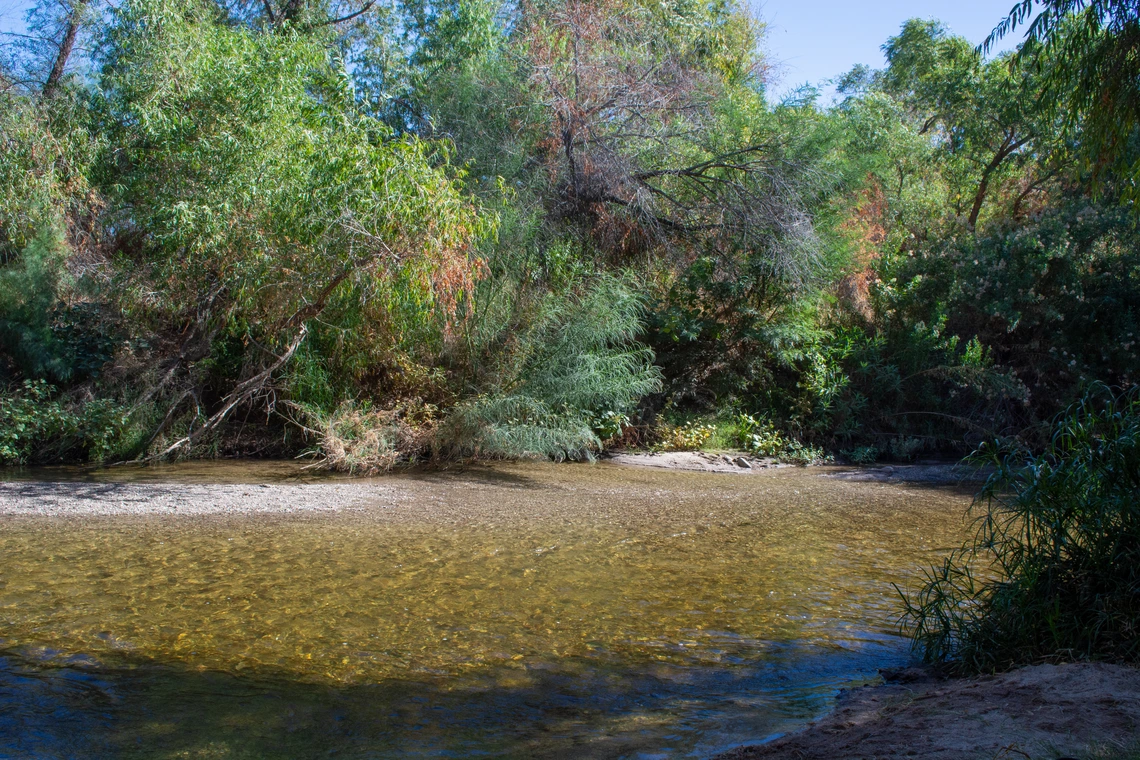
This stretch of the Santa Cruz River, north of Tucson near Marana, receives 100% of its flow when it's not raining from treated wastewater effluent. Especially over the past 10 years, this water has supported a reinvigoration of aquatic and riparian habitats along the river.
Aside from the economic benefits of Arizona’s aquatic ecosystems, for Bonar, desert fishes and other species who rely on these environments are beautiful and worth protecting, in and of themselves.
“Take a look at this animal. You've got a genetic code that, filled out in regular letters, would stretch from San Francisco to New York, and this genetic code is unique, like a masterpiece,” Bonar said. “You've got paintings in the Louvre, and you've probably not seen them, you certainly don't use them every day, but we still preserve them. So why don't we care for some of these unique animals that are genetic masterpieces just like those paintings.”
Fostering that sense of wonder is one of Bogan’s goals through the BIORETS program. It’s especially important, he says, because of the immense influence the local Tucson community has over the Santa Cruz River. When it’s not raining, 100 percent of the water flow comes from high quality effluent, and that only happens because it’s a priority for the community and local officials.
“Those students today are going to go home and tell their families about it, and eventually, we've reached a few hundred people who’ve heard about the river and how amazing a resource it is,” he said

